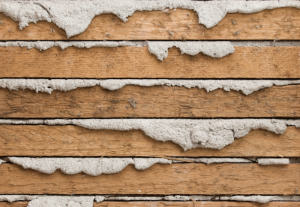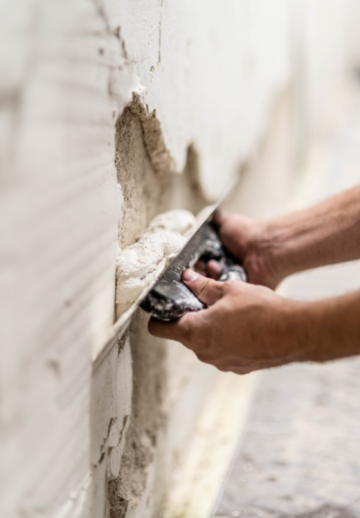How To Repair Horsehair Plaster Walls
Repair and maintenance of Horsehair Plaster walls in the Boston Area
What is horsehair plaster?
Horsehair plaster is unremarkably used in older South Shore and Boston-expanse homes. It is composed of water, lime, aggregate, and sometimes animal hair. Homebuilders used horsehair to bind the plaster mixture together and add strength to it. Underneath all types of antique plaster, you'll observe closely spaced strips of wood that are nailed to the studs called "lath." The wood lath has spaces between them that assistance the mortar and plaster layers "grip" the woods while drying.
Why was horsehair added to plaster in the Boston region?
 The purpose of calculation creature hair to the plaster mixture was as a bridging amanuensis. When the lime mixture was applied to the wooden lath, small-scale points formed in plaster, creating a nib that helped the mixture stick to the wood lathing. Animal hair helped to bridge the nibs together and added to the strength and longevity of the plaster. The animal pilus also helped reduce the shrinkage of the plaster. Before the inflow of the machine, equus caballus'due south pilus was plentiful, and because the horsehair was long and strong, it made a skilful pick for this application.
The purpose of calculation creature hair to the plaster mixture was as a bridging amanuensis. When the lime mixture was applied to the wooden lath, small-scale points formed in plaster, creating a nib that helped the mixture stick to the wood lathing. Animal hair helped to bridge the nibs together and added to the strength and longevity of the plaster. The animal pilus also helped reduce the shrinkage of the plaster. Before the inflow of the machine, equus caballus'due south pilus was plentiful, and because the horsehair was long and strong, it made a skilful pick for this application.
Can horsehair plaster walls be repaired?
 Yes, holes and imperfections in the horsehair plaster can exist filled with joint compound. Larger holes tin be repaired past cutting out the degraded plaster and plumbing equipment a piece of bluish board in the hole, then using plaster or joint compound to alloy the repaired hole. Some homeowners like the divots, imperfections, and uneven look of their horsehair plaster walls. If yous repair holes in plaster walls, make sure these patches completely dry before paint is applied. If the joint compound or underlying plaster is not dry out before painting, the paint is probable to peel. You tin tell the repaired expanse of plaster is dry when there are no dark patches on the wall and the plaster repair has turned lighter.
Yes, holes and imperfections in the horsehair plaster can exist filled with joint compound. Larger holes tin be repaired past cutting out the degraded plaster and plumbing equipment a piece of bluish board in the hole, then using plaster or joint compound to alloy the repaired hole. Some homeowners like the divots, imperfections, and uneven look of their horsehair plaster walls. If yous repair holes in plaster walls, make sure these patches completely dry before paint is applied. If the joint compound or underlying plaster is not dry out before painting, the paint is probable to peel. You tin tell the repaired expanse of plaster is dry when there are no dark patches on the wall and the plaster repair has turned lighter.
Tin I pigment my horsehair and plaster walls?
Yep. A latex primer and two low-cal coats of flat latex wall paint are used to paint horsehair plaster walls.
What paint sheen should I use on my plaster walls?
Using a flat paint sheen (as opposed to a glossier sheen) on the plaster walls keeps the plaster looking most authentic. Likewise, flat paint will hibernate rough imperfections in the plaster. Conversely, using paint sheens similar eggshell and satin can help highlight the plaster'south imperfect adroitness past adding a glossier and more light-reflecting surface.
How to remove wallpaper coverings from horsehair and plaster walls:
If you lot accept wallpaper covering your horsehair plaster walls and want to remove the wallpaper, you must steam it off. Practise not score the wallpaper considering you could gouge and damage the underlying horsehair plaster or even crusade information technology to crumble. Scoring the wallpaper also poses a adventure of exposing you to potentially toxic plaster dust. You lot also cannot use harsh solvents to deliquesce the wallpaper glue considering doing so could also dissolve the plaster compound.
Tin can I drywall over horsehair plaster?
Yes, as long as the plaster is firmly bound to the wooden lath beneath information technology, sheetrock can be directly bonded to the plaster surface using a dot and dab method.
Is horsehair plaster used to build mod homes?
No horsehair plaster has been replaced with a more than modernistic plastering technique where bluish board (a blazon of gypsum lath) is installed on the studs, the seams are taped and a layer of plaster is troweled on to form a Jin plaster coating that is smoother and harder than drywall. This more than modernistic method of installing plaster walls and is seen in many upscale homes on the South Shore.
Should I continue my horsehair plaster walls?
This is a personal choice. Many of our Clients like to preserve and repair their older horsehair plaster walls to remain historically authentic. If y'all live in a business firm congenital before the 1940s, you likely have plaster walls, and as long as the plaster is in good shape, it usually makes sense to keep them.
Removing horsehair plaster walls is messy and costly. Plaster grit is tough to incorporate, and homeowners report finding plaster dust in places years afterwards the plaster walls take been removed. Besides, studs in sometime homes tend to exist uneven, so even after removing the plaster wall, you may find the studs unsuitable for drywall installation. Horsehair plaster walls are handmade so they are not perfect which adds to the handcrafted experience of the home.

Plaster is easy to contour, providing delicate archways and lovely curves, especially around windows and entrances. Drywall is less able to be contoured in this way because it is too rigid, then homes with drywall tend to take primarily rectangular angles.
Why would someone decide to remove a horsehair plaster wall?
The reasons to remove a horsehair plaster wall can include the following:
To install insulation into exterior walls, it's often necessary to accept down the horsehair plaster walls. Homes with horsehair plaster walls tend to be poorly insulated and we often encounter very primitive forms of insulation behind the plaster, such equally newspaper and hay. If your home is drafty and uninsulated, information technology may brand sense to remove the horsehair plaster, insulate the outside walls using modernistic insulation, and reconstruct the exterior walls using drywall. Adding insulation usually occurs on only the exterior walls of your home, and so y'all can go out your interior plaster walls intact. Since the exterior walls tend to be rectangular anyway, so using drywall subsequently you insulate the outside walls won't damage the charm of the habitation – you tin keep the amuse by keeping the interior plaster walls with their curves and imperfections.
Converting an older habitation to an open-floor plan or changing the room configurations, homeowners often have down horsehair plaster walls.
If a horsehair plaster wall is in disrepair, it'due south sometimes easier to remove the whole wall and replace information technology with sheetrock or modern plaster walls.
If a homeowner is updating HVAC, electrical, cable, or ethernet wiring in a home with horsehair plaster walls, the snaking of new wire and pipage can be difficult or impossible behind a horsehair plaster wall because it is very little or no space in which to ophidian the wires.
Is horsehair plaster dangerous?
Horsehair plaster and grit tin can exist potentially dangerous considering they may incorporate asbestos and anthrax spores. If you castor the plaster, you risk exposing yourself to the plaster dust and exposing yourself to these spores. Homes with darker horsehairs visible in the plaster tend to exist safer, but lighter fibers visible in your plaster walls indicate a more likely presence of asbestos. The best way to determine if your plaster walls contain asbestos is to accept them professionally tested.
For people allergic to animal pilus, horsehair plaster is non the best environment to live in and could trigger allergy symptoms.
Yous may also similar to read:
Colors to paint your historic abode
Our portfolio of recent painting projects
Source: https://certapro.com/boston-south-shore/community/maintenance-of-horsehair-plaster-walls-in-the-boston-area/

0 Response to "How To Repair Horsehair Plaster Walls"
Post a Comment